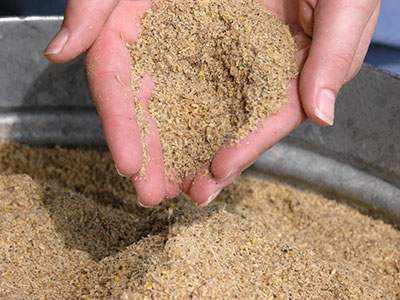
PIC Update – October 2013
By Kimberley Sheppard and Dr. Martin Zuidhof
Features Farmer Health/Safety Health Biosecurity Business/Policy Canada ProtectionAntibiotic Strategies
 Antibiotics in feed are under fire due to consumer concerns.
Antibiotics in feed are under fire due to consumer concerns. Antimicrobials are used in the broiler industry routinely. Not only do they improve performance (growth, feed conversion and meat yield), but they also reduce the risk of consumers being exposed to food-borne pathogens. Food safety is a significant and growing issue for consumers internationally, and food-related illnesses or deaths often have devastating impacts on entire food supply chains.
Despite the benefits that antibiotics provide, there are also potential drawbacks, and their use in animal feeds is under fire. Due to consumer concern, the pressure to ban antibiotic use in poultry feed continues to increase. The primary concerns of the poultry industry for a ban on antibiotic use are potential reductions in production performance and bird welfare.
To address these concerns, Dr. Martin Zuidhof and his research team at the University of Alberta have been investigating ways to reduce the prophylactic use of antibiotics in poultry feed. Their aim is to enhance consumer confidence through discovery of effective alternative approaches such as nutritional interventions that can prevent the onset of disease in a novel, non-pharmaceutical manner.
The research team approached the problem using two separate research trials. The first trial investigated the use of antibiotics on broiler chicken production. They fed groups two strains of broiler chicks one of four antibiotic treatments (no antibiotic, Bacitracin Methylene Disalicylate (BMD), Roxarsone and Virginiamycin) during the starter and grower periods. They measured feed conversion ratio, mortality, and weights of carcass, breast, leg and wing.
The second trial studied the effect of dietary changes that could prepare the immune system to respond quickly and effectively to disease challenges. They investigated the use of nutrient density intervention during the first two weeks, with the addition of either: HyD (a readily available form of vitamin D), and BMD, on growth performance, carcass parameters, intestinal morphology and immune function. Chickens were fed either high- or low-density diets with and without HyD, and with and without BMD, all at recommended levels. Carcass and meat yield, the capacity of blood cells to kill bacteria and other immune responses were measured.
During both trials, a necrotic enteritis outbreak occurred. In trial 1, BMD and Virginiamycin reduced mortality from necrotic enteritis. While strain A birds on the no-antibiotic treatment had higher mortality from necrotic enteritis compared to strain B birds, the addition of BMD and Virginiamycin negated that difference. As well, birds fed diets with antibiotics had lower feed conversion ratio than birds fed no antibiotics. Meanwhile, strain B birds had higher feed conversion ratio at day 35. Neither strain nor antibiotic treatments had an effect on breast muscle weight.
Lastly, the overall economic impact of antibiotic feeding was a cost reduction of around $0.10/kilogram. This trial confirmed the complexity of understanding the issue of banning prophylactic antibiotics, due to the multi-factorial influences of strain and antibiotic type on economics, health and welfare.
In trial 2, the high-density diet increased body weight and meat yield, and decreased feed conversion ratio. High nutrient density resulted in higher net returns, and a nearly significant increase in bacteria killing capacity. BMD reduced mortality compared to birds fed no antibiotics, while HyD increased factors related to the immune response without causing a decrease in performance.
Overall, the replacement of antibiotics is a complex challenge because of multi-factorial influences on health and the immune system. Dr. Zuidhof feels that the most likely pathway to successful antibiotic-free poultry production will be the development of an interdependent-systems approach involving both management and nutrition, potentially including the two methods investigated here, but much broader. Sustainability of the poultry industry will require investment in whole-systems approaches to promote and enhance poultry health.
Print this page